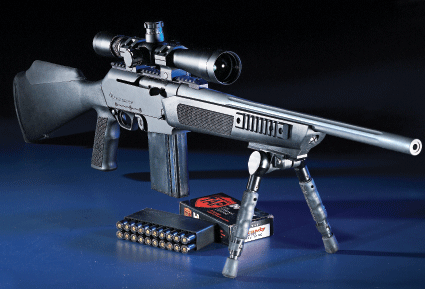The FNH USA FNAR .308 is the latest tactical innovation from a company that provides 70 percent of the small arms in use by American troops. With roots stemming from the contemporary Browning BAR hunting rifle, the new FNAR has matured into a fast autoloading rifle capable of delivering bolt action accuracy. In fact, every FNAR is capable of at least 1-MOA, just like the FN SPR precision rifles.
The original Browning Automatic Rifle was a family of American-made 7.62mm automatic rifles that fought at the Argonne in World War I and saw service in the Vietnam War. Although the FNAR has no relationship to the original M1918 BAR, there are quite a few qualities that echo the famed battle rifle heralded by boots on the ground.
The FNAR is a lightweight, short-stroke piston-driven, semi-automatic rifle. The FNAR’s gas piston system is concealed within the stock just below the barrel. The bolt 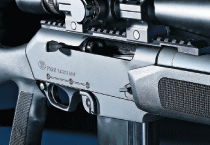 locks a .308 cartridge into the barrel’s chamber by means of a rotary system and multiple lugs. The FNAR features a precision-machined 7075-T6 aircraft-grade aluminum alloy receiver with a black anodized finish.
locks a .308 cartridge into the barrel’s chamber by means of a rotary system and multiple lugs. The FNAR features a precision-machined 7075-T6 aircraft-grade aluminum alloy receiver with a black anodized finish.
Advertisement — Continue Reading Below
Set into a matte black polymer stock, the FNAR is designed with dimensions suited to those familiar with the M16/M4 platform. This familiarity continues to the firing hand that wraps the M16/M4-style textured pistol grip. Utilizing five stock shims, three cheekpieces and three recoil pads supplied by FN, this rifle can be configured to a number of body types. I opted to replace the standard recoil pad with the largest to increase the length of pull to more than 14 inches before testing this rifle on the range. I didn’t have a need to fit the stock further using one of the shims and I can’t picture a lot of these rifles in the field utilizing them. But for those agencies or units that have time to fine-tune an FNAR using shims, go for it.
The FNAR’s safety is located on the triggerguard just behind the trigger. Like most crossbolt safeties, pushing the button completely to the right puts it on safe and blocks the rearward travel of the trigger. With the safety pushed to the left, the rifle’s safety is disengaged and ready to fire. A small red band is visible on the crossbolt when the safety is off. This safety can be reversed by a qualified armorer in order to accommodate left-handed shooters, making this safety unlike others of this type.
Pulling the trigger of the FNAR is a welcomed experience. The primer is struck after just 0.10 of an inch travel and with a crisp release. This is the best trigger I’ve fired on a tactical rifle in the last few months and I couldn’t afford to do it enough. Reset is predictable shot after shot. Using an RCBS trigger pull gauge, 4 pounds was all that was required to make the shot.
Advertisement — Continue Reading Below
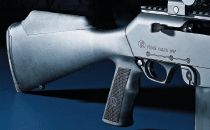 Typically, there is some variance between measurements of a trigger but ten trigger pulls produced the exact same result.
Typically, there is some variance between measurements of a trigger but ten trigger pulls produced the exact same result.
When the last round is fired, the FNAR’s bolt locks to the rear, exposing an empty magazine and chamber. In keeping with the universal theme, an ambidextrous button behind the magazine well releases the FN’s feeding device. With another magazine inserted and the bolt held to the rear, two methods will release the bolt, sending it forward to strip a round from the magazine and into the chamber. 1) A spring-loaded level called the “bolt lock” is located on the right side of the receiver, just behind the forearm. With the bolt’s extended charging handle pulled to the rear, the lever can be used to manually lock the bolt rearward by moving it in the upward position. Pressing down on the lever with the bolt to the rear will send the bolt home. 2) Charging the rifle can also be accomplished by pulling the extended charging handle fully to the rear and letting go.
The FNAR is available in either a lightweight or heavy fluted barrel configuration. A recessed target crown helps protect the muzzle and exposed rifling at the muzzle. Both offerings are hammer forged with a 1-in-12-inch twist rate, hard chrome-plated bore, and tested to pressures that substantially exceed safety margins established by American loads. Fluting is incorporated in this autoloader in order to keep temperatures down and contribute to an overall weight savings.
Advertisement — Continue Reading Below
Shooting Impressions
FN guarantees at least 1-MOA accuracy from the FNAR. It’s a bold statement that begs to be verified. To do so, I selected three of the best loads available including Winchester’s 168-grain Ballistic Silvertip, Federal’s 168-grain Gold Medal Match, and Hornady’s 110-grain TAP. The two 168-grain loads would confirm the accuracy in a popular bullet weight 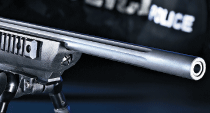 while the 110-grain load would certify my curiosity. I expected a shift in impact but I was interested to see if a difference in bullet weight would change the rifle’s accuracy potential.
while the 110-grain load would certify my curiosity. I expected a shift in impact but I was interested to see if a difference in bullet weight would change the rifle’s accuracy potential.
Settling into a prone position, I utilized the FNAR’s swivel stud and attached an adjustable bipod from Harris. Placing two sandbags in front of the bipod, I like to dig the bipod’s feet into the ground and lean heavily into the rifle. In this position, a shooter recovers rapidly for follow-up shots with little effect on position and stock weld.
Considering the tactical nature of the FNAR, I mounted the Leupold Mark 4 in a set of Warne QD rings to the top-mounted MIL-STD-1913 accessory rail. Although this test would utilize a long-range-capable riflescope, mounting a red dot in place of a scope or attaching weapon lights and target designators to any of the accessory rails effectively expands this rifle’s mission potential.
Advertisement — Continue Reading Below
Sighting in the Leupold and getting the rifle on paper was accomplished using a small batch of military ball. I didn’t have enough to include it in the accuracy test, but it’s worth mentioning that one group of 5-shot sighters measured 1.14 inches. Once I was hitting near the target’s white diamond, I loaded a 20-round magazine with Winchester ammo.
Winchester’s Ballistic Silvertip is a Nosler bullet with a polycarbonate tip that resists deformation and aids expansion. The black oxide LUBALOX coating aids in the tactical appearance and reduces engraving forces and barrel fouling as the bullet passes through the bore. With an average group size measure just over 1.6 inches, the FNAR didn’t favor the Winchester’s Nosler bullet, but I did obtain one sub-MOA group. In service of anyone that wears a uniform, it’s still an excellent choice for duty. The polycarbonate tip resists deformation and aids expansion while a barrel’s life is extended due to reduced fouling and engraving forces.
Federal’s Gold Medal Match is always a high performing cartridge worth the money when you can’t afford to miss. These loads feature the Sierra MatchKing boattail hollow point, a bullet that has brought victory to competitive shooters and success to snipers around the world. It was no surprise to me that this ammo produced the best results, a 0.98 of an inch average with a best group measuring just under 0.61 of an inch. Three out of five groups were sub-MOA, satisfying FN’s accuracy guarantee.
Advertisement — Continue Reading Below
TAP ammo is a personal defense cartridge from Hornady that has an enormous following in the LE community. Due to the targeted use, I was interested to know how it would work in the FNAR. Every shot functioned flawlessly and the groups impacted 3.5 inches higher than the 168-grain loads at 100 yards. Just 14-quarter-minute clicks later, TAP rounds were landing at point-of-aim/point-of-impact. A few groups hovered 1-MOA, proving to me that using a lighter bullet like the 110-grain TAP round in the FNAR should be a tactical consideration.
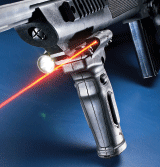 This rifle’s appetite is temporarily satisfied with either a 10- or 20-round detachable, double-column, box magazine. Even though the FNAR was capable of dumping the larger capacity magazine in less than 8 seconds, it’s plentiful for many applications in this .308-chambered semi-auto. The magazines are specifically designed for the FNAR and shouldn’t be confused with magazines like the M1A. This high capacity magazine features a low friction follower that proved extremely reliable on the range.
This rifle’s appetite is temporarily satisfied with either a 10- or 20-round detachable, double-column, box magazine. Even though the FNAR was capable of dumping the larger capacity magazine in less than 8 seconds, it’s plentiful for many applications in this .308-chambered semi-auto. The magazines are specifically designed for the FNAR and shouldn’t be confused with magazines like the M1A. This high capacity magazine features a low friction follower that proved extremely reliable on the range.
Final Notes
Set up the FNAR just the way you need it. Multiple accessory rails allow any shooter to install a battery of tactical lights and target designators. Interchangeable cheekpieces assist in obtaining the ideal eye-to-scope alignment. One of three recoil pads adjusts the length of pull and effectively aids in felt recoil reduction.
Advertisement — Continue Reading Below
A tactical autoloader in .308 that shoots at least 1-MOA before leaving the factory is impressive. One that’s as mission-configurable for urban operations as FN’s new FNAR deserves everyone’s attention.
